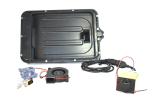Anybody else been perusing the latest version of AC 91-78?
There's some stuff that, if I'm interpreting this correctly, makes me glad it's advisory and not regulatory. The FAA seems to go in circles through several ACs, using conflicting terms and contradictory statements. If you're interested, grab a pot of coffee and a bottle of extra-strength Tylenol. The AC, with its confusing and conflicting language, would upend the way we currently use our iPads and tablets if taken literally.
BLUF - This AC revision, taken at face value, will make any iPad or tablet or similar device an "installed" component if it's on a yoke clip or suction mount or if it's receiving GPS or other data from installed hardware. Being "installed" means it will require at least a logbook entry as a minor modification, and it might require an STC. Further, if it's "installed" you will need an A&P to make a logbook entry every time it goes in or out of your plane.
Previously, EFBs were designated as Class 1, 2, or 3, where class 3 EFBs were installed equipment requiring an STC. Now all EFBs are categorized as "Portable" or "Installed."
A few gems (and some comments):
91-78 says a portable device can't connect to aircraft data, whereas 120-76 clearly says it can.
There's also what I hope is poor wording in 91-78 part 9.1:
What a mess.
For now, I plan to ignore this advice and to continue connecting my iFly 740b to my Stratus ESG via wifi and plugging its power cord into my plane's cigarette lighter and enjoying the capabilities and enhanced safety it gives me.
There's some stuff that, if I'm interpreting this correctly, makes me glad it's advisory and not regulatory. The FAA seems to go in circles through several ACs, using conflicting terms and contradictory statements. If you're interested, grab a pot of coffee and a bottle of extra-strength Tylenol. The AC, with its confusing and conflicting language, would upend the way we currently use our iPads and tablets if taken literally.
BLUF - This AC revision, taken at face value, will make any iPad or tablet or similar device an "installed" component if it's on a yoke clip or suction mount or if it's receiving GPS or other data from installed hardware. Being "installed" means it will require at least a logbook entry as a minor modification, and it might require an STC. Further, if it's "installed" you will need an A&P to make a logbook entry every time it goes in or out of your plane.
Previously, EFBs were designated as Class 1, 2, or 3, where class 3 EFBs were installed equipment requiring an STC. Now all EFBs are categorized as "Portable" or "Installed."
A few gems (and some comments):
10.1 Portable EFBs
1. Not dependent upon a dedicated aircraft power source or input from navigation
equipment to provide display functionality, although they may connect to aircraft
power through a certificated power source;
2. Not attached to an aircraft mounting device; and Sounds like it's only portable if it's on your kneeboard or held in your hand.
3. Not connected with or receiving data from any aircraft system. Wouldn't this preclude getting GPS and traffic data from a Stratus ESG or similar?
10.2 Installed EFBs
1. Receive power from the aircraft that is derived from an electrical bus source protected
against short circuits with an appropriately rated circuit breaker or fuse;
2. Receive position reference from an onboard navigation system, provided such input is
designed and integrated in such a manner as to not adversely affect the output of the
navigation source to which they are connected; and Looks like using wifi from an onboard GPS makes the EFB "installed."
3. Be attached to a mounting device provided that such device is approved for
installation into the aircraft (e.g., if intended for installation into a type-certificated
aircraft, then such mounting device must meet the requirements of 14 CFR part 21,
§ 21.303). This would seem to include ram mounts, suction cups, yoke clips, etc., but what does "approved" mean here? Is an STC required?
4. Refer to AC 20-173, Installation of Electronic Flight Bag Components, for complete
details for installation of EFB components. Here we start down a rabbit trail. AC 20-173 further refers to AC 120-76 which in turn points back to AC 20-173. AC 120-76, though, seems to conflict with AC 91.78A by calling out the stuff we've counted on all along. IOW, 120-76 tells us:
In the context of this AC, EFB
equipment components supporting EFB applications are “installed” when they are
incorporated into aircraft type design under 14 CFR part 21, or as a proper alteration
under 14 CFR part 43, § 43.3. All other components supporting EFB functionality are
considered “portable,” regardless of how often they are removed from the aircraft. In
order for portable EFB hardware to support EFB applications, installation of at least some
EFB components may be required, depending on requirements for positional integrity
(e.g., installed mounts), continuity of power (e.g., dedicated primary power port), and
data connectivity (e.g., Wireless Fidelity (Wi-Fi ®
), and Ethernet). Airworthiness
regulations do not apply to portable EFB components other than for specifications
associated with the installed components (i.e., mounting (size and weight), power
(maximum electrical load, voltage, and current frequency), and data connectivity...
120-76 also (blessedly) tells us:
9.1.2 Portable EFB Hardware Components:
• Must be capable of being easily removed from or attached to their mounts by
flightcrew member personnel without tools or maintenance action.
• Can be temporarily connected to an existing aircraft power port for battery
recharging.
• May connect to aircraft power, data ports (wired or wireless), or installed antennas,
provided those connections are installed in accordance with AC 20-173.
So we have 91-78 telling us that if an EFB uses a mounting device it's "installed," whereas 120-76 (a third-level reference) tells us those mounting components are only installed when part of the type design or incorporated as an approved alteration (I'd assume a "minor alteration), and the components are portable if they can be easily removed without tools or maintenance action.91-78 says a portable device can't connect to aircraft data, whereas 120-76 clearly says it can.
There's also what I hope is poor wording in 91-78 part 9.1:
2. The EFB system on board the aircraft displays only information which is functionally
equivalent to the paper reference material which the information is replacing or is
substituted for.
That "only" seems nuts. Taken literally this would mean that the EFB system cannot display (for example) ADSB traffic or weather.What a mess.
For now, I plan to ignore this advice and to continue connecting my iFly 740b to my Stratus ESG via wifi and plugging its power cord into my plane's cigarette lighter and enjoying the capabilities and enhanced safety it gives me.
Last edited:







